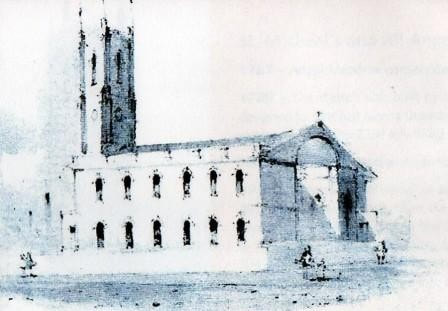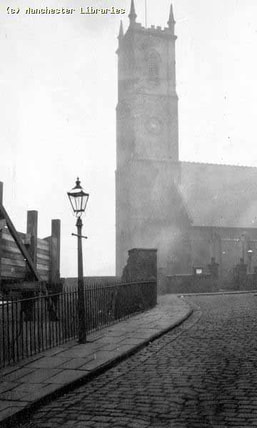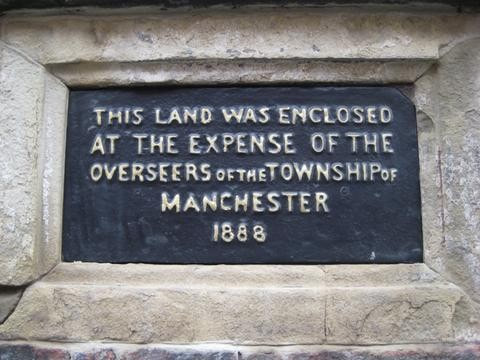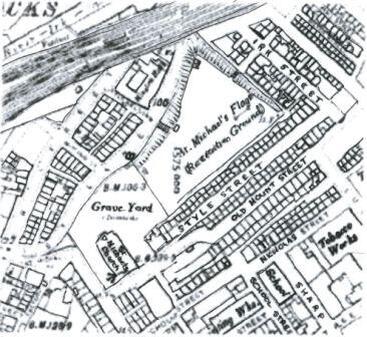St Michael's & All Angels Church

St Michael's and All Angel's church was built in 1788 by Humphrey Owen, to seat just over a thousand people. Its foundation stone was laid on May 20, 1788 and it was consecrated on July 23, 1789. Almost twenty years later, a letter appeared in the Manchester Guardian declaring
"Why one of the ugliest churches in Manchester situated in one of the most crowded and notorious parts of the City should have so long enjoyed the pleasant sounding name 'St Michael's, Angel Meadow' is beyond understanding."
The land adjacent to the church became the largest cemetery in Manchester, used for the interment of those who had no family place of burial or were too poor to afford a proper funeral.
"Why one of the ugliest churches in Manchester situated in one of the most crowded and notorious parts of the City should have so long enjoyed the pleasant sounding name 'St Michael's, Angel Meadow' is beyond understanding."
The land adjacent to the church became the largest cemetery in Manchester, used for the interment of those who had no family place of burial or were too poor to afford a proper funeral.

In 1844, the Oldham Road terminus of the Manchester-Leeds Railway was abandoned and the line extended through Collyhurst to a new link station at Hunts Bank - the first Victoria Station. A railway viaduct traversed Angel Meadow, whilst the obnoxious smells from the Rivers Irk and Irwell as well as the Gould Street gas works darkened the landscape.
As the area deteriorated with the proliferation of Irish Catholic immigrants inhabiting the poorest neighbourhood, and the Georgian Houses became lodging houses, church attendance fell.
Ragged Schools, such as Charter Street and Sharp Street, and other institutes for abandoned, destitute and neglected children, flourished in the area.
There were improvements to the church from time to time - first "colossal saints" were thrown out, then the galleries and three decker pulpit were removed, a new roof provided.
When the Rev Jowitt Wilson was appointed rector in 1913, he arrived to find a church heavily in debt, a church door without a handle and cats and kittens in the organ! Nevertheless in his 14 years as rector he did tremendous work - he persuaded the parks committee to turn the dismal churchyard into a garden, opened the tower prayer room for daily prayer and a rectory was built. Worn out, Mr. Wilson died in 1928 after being an invalid for 9 months.
Church attendance fell following slum clearances and general depopulation of the area and was finally demolished in 1935.
As the area deteriorated with the proliferation of Irish Catholic immigrants inhabiting the poorest neighbourhood, and the Georgian Houses became lodging houses, church attendance fell.
Ragged Schools, such as Charter Street and Sharp Street, and other institutes for abandoned, destitute and neglected children, flourished in the area.
There were improvements to the church from time to time - first "colossal saints" were thrown out, then the galleries and three decker pulpit were removed, a new roof provided.
When the Rev Jowitt Wilson was appointed rector in 1913, he arrived to find a church heavily in debt, a church door without a handle and cats and kittens in the organ! Nevertheless in his 14 years as rector he did tremendous work - he persuaded the parks committee to turn the dismal churchyard into a garden, opened the tower prayer room for daily prayer and a rectory was built. Worn out, Mr. Wilson died in 1928 after being an invalid for 9 months.
Church attendance fell following slum clearances and general depopulation of the area and was finally demolished in 1935.

Parochial Burial Ground
The parish burial ground was open between 1788-1816 when as many as 40,000 poor people may have been buried there.
Quote from Friedrich Engel's in his Conditions of the Working Classes in England.
"In Manchester, the pauper burial ground lies opposite the Old Town, along the Irk: this is a rough desolate place. About two years ago a railroad was carried through it. If it had been a respectable cemetery, how the bourgeoisie would have shrieked over the desecration! But it was a pauper burial ground, the resting place of the outcast and the superfluous, so no one concerned himself about the matter. It was not even thought worthwhile to convey the partially decayed bodies to the other side of the cemetery; they were heaped up just as it happened, the piles were driven into newly made graves, so that the water oozed out of the swampy ground, pregnant with putrefying matter, and filled the neighbourhood with the most revolting and injurious gases.
The disgusting brutality which accompanied this work I cannot describe in further detail".
The process of constructing the burial pits was described as thus:
A very large grave, or more properly, a pit for the reception of mortality, is digged, and covered up, (when not actually in use for depositing the remains of the dead) with planks, which are locked down in the night, until the hole is filled up with coffins piled beside and upon one another. The cavern of death is then closed, and covered up with earth; and another pit is prepared, and filled in the same manner.
The parish burial ground was open between 1788-1816 when as many as 40,000 poor people may have been buried there.
Quote from Friedrich Engel's in his Conditions of the Working Classes in England.
"In Manchester, the pauper burial ground lies opposite the Old Town, along the Irk: this is a rough desolate place. About two years ago a railroad was carried through it. If it had been a respectable cemetery, how the bourgeoisie would have shrieked over the desecration! But it was a pauper burial ground, the resting place of the outcast and the superfluous, so no one concerned himself about the matter. It was not even thought worthwhile to convey the partially decayed bodies to the other side of the cemetery; they were heaped up just as it happened, the piles were driven into newly made graves, so that the water oozed out of the swampy ground, pregnant with putrefying matter, and filled the neighbourhood with the most revolting and injurious gases.
The disgusting brutality which accompanied this work I cannot describe in further detail".
The process of constructing the burial pits was described as thus:
A very large grave, or more properly, a pit for the reception of mortality, is digged, and covered up, (when not actually in use for depositing the remains of the dead) with planks, which are locked down in the night, until the hole is filled up with coffins piled beside and upon one another. The cavern of death is then closed, and covered up with earth; and another pit is prepared, and filled in the same manner.

Opposite Nelson Street were the Angel Steps into the lower burial ground - so called because of the many apparitions of angels witnessed by local inhabitants, who assumed that they were there to guard the graves of the many hundreds of infants.
The fascination of the burial ground, also called "The Flags" was irresistible. According to the rumor there were well over forty thousand bodies beneath the stones, all victims of poverty and sickness, whose mass grave had from time to time been plundered by fellow humans and the elements.
The population density of Angel Meadow in the mid-19th century was in excess of 350 per acre, and as social and living conditions worsened some resorted to digging up the cemetery and selling its soil as fertilizer to nearby farmers. The situation became so bad that an Act of Parliament was passed in 1855 to cover up graveyards with flagstone, hence the name, St Michael's Flags.
Many reports give mention to the rats of Angel Meadow, which, attracted by the cheese cellars at Hanging Ditch nearby, would migrate in wildebeest like droves across the meadow after dark. The parochial burial ground finally closed in 1816.
The boundaries of the burial ground were enclosed by the Aspin Lane Wall in 1888 to prevent the bodies being washed down the slope.
The "flags" became a renowned meeting point for the staging of fights between women as well as men, and the local Irish played a game with a bat against a board.
The lower burial ground had a bandstand which held concerts twice a week and a children's playground was also installed- as depicted in LS Lowry's The Steps at Irk Place .
Local Collyhurst lad and 1966 World Cup winning footballer, Nobby Stiles honed his skills on the stone flagged football pitch.
Recent regeneration work in 2014 revealed bodies which are now interred in Southern Cemetery in Manchester.
Further information can be found in Forgotten Fields: Looking for Manchester's Old Burial Grounds by John Marsden.
The fascination of the burial ground, also called "The Flags" was irresistible. According to the rumor there were well over forty thousand bodies beneath the stones, all victims of poverty and sickness, whose mass grave had from time to time been plundered by fellow humans and the elements.
The population density of Angel Meadow in the mid-19th century was in excess of 350 per acre, and as social and living conditions worsened some resorted to digging up the cemetery and selling its soil as fertilizer to nearby farmers. The situation became so bad that an Act of Parliament was passed in 1855 to cover up graveyards with flagstone, hence the name, St Michael's Flags.
Many reports give mention to the rats of Angel Meadow, which, attracted by the cheese cellars at Hanging Ditch nearby, would migrate in wildebeest like droves across the meadow after dark. The parochial burial ground finally closed in 1816.
The boundaries of the burial ground were enclosed by the Aspin Lane Wall in 1888 to prevent the bodies being washed down the slope.
The "flags" became a renowned meeting point for the staging of fights between women as well as men, and the local Irish played a game with a bat against a board.
The lower burial ground had a bandstand which held concerts twice a week and a children's playground was also installed- as depicted in LS Lowry's The Steps at Irk Place .
Local Collyhurst lad and 1966 World Cup winning footballer, Nobby Stiles honed his skills on the stone flagged football pitch.
Recent regeneration work in 2014 revealed bodies which are now interred in Southern Cemetery in Manchester.
Further information can be found in Forgotten Fields: Looking for Manchester's Old Burial Grounds by John Marsden.
